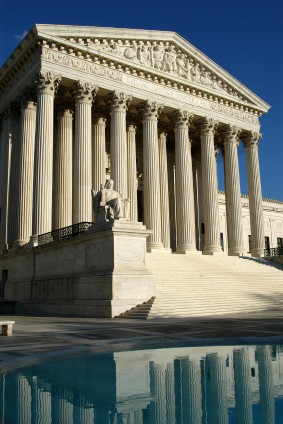Show posts for: Religious Discrimination
-
 Read more
Read moreYesterday, the Supreme Court heard argument in the religious discrimination case of EEOC v. Abercrombie & Fitch Stores, Inc., which made our list as one of our five issues to watch for 2015. The case arises under Title VII, the federal law that makes it illegal for an employer “to discriminate against any individual with respect to h[er] compensation, terms, conditions, or privileges of employment, because of such individual’s . . . religion.” The EEOC alleges that Abercrombie, purveyor of “authentic American clothing,” discriminated against Samantha Elauf on religious grounds. The company refused to hire Elauf because she wore a headscarf, or hijab, to her job interview, and the company’s “Look Policy” prohibited employees from wearing “caps.”
In earlier depositions in the case, Elauf’s interviewer at Abercrombie testified that she “assumed that [Elauf] was Muslim,” and “figured that was the religious reason why she wore her head scarf.” The interviewer said that she went to her district manager to discuss the headscarf issue, and told him that “[Elauf] wears the head scarf for religious reasons, I believe.” The interviewer testified that the district manager then told her not to hire Elauf because of the headscarf and said, “[S]omeone can come in and paint themselves green and say they were doing it for religious reasons, and we can’t hire them.” As a result, the interviewer lowered Elauf’s “appearance” score on her evaluation, and Elauf didn’t get the job.
Despite this testimony, the Tenth Circuit still entered summary judgment for Abercrombie, holding that the EEOC’s discrimination claim could not proceed to trial because Elauf “never informed Abercrombie prior to its hiring decision that she wore her headscarf or ‘hijab’ for religious reasons and that she needed an accommodation for that practice, due to a conflict between the practice and Abercrombie’s clothing policy.”
The fact that the Tenth Circuit granted summary judgment, even though the interviewer admitted that she assumed that Elauf wore the scarf for religious reasons, helps explain the concerns, and potential solutions, that the Justices raised in yesterday’s argument.
-
 Read more
Read moreIn our last post, we counted down our most popular posts of 2014, from A-Rod to Walgreen. Now it’s time to take a look at the issues in executive disputes that are likely to draw plenty of attention in 2015.
1. Dodd-Frank Bounties and Whistleblower Litigation on the Rise
In November 2014, the SEC released its annual report on its Dodd-Frank whistleblower award program. The theme of the report is that Dodd-Frank is paying off – both for the SEC and for whistleblowing employees. The SEC reported that it issued whistleblower awards to more people in its 2014 fiscal year than in all previous years combined, including a $30 million bounty to one whistleblower in a foreign country. The number of whistleblower tips received continues to increase, and we expect news of more substantial awards in 2015. Meanwhile, litigation over various Dodd-Frank issues, such as whether a whistleblower claim is subject to arbitration, whether the shield against whistleblower retaliation applies overseas, and whether a whistleblower must report to the SEC in order to bring a retaliation claim, will continue to percolate in the federal courts.
2. The Supreme Court Weighs in on Employment Issues
A couple of key Supreme Court cases will address employee rights that apply across the board, from the C-suite to the assembly line. In Young v. United Parcel Service, the Court will decide whether, and in what circumstances, the Pregnancy Discrimination Act requires an employer that accommodates non-pregnant employees with work limitations to accommodate pregnant employees who have similar limitations. And in EEOC v. Abercrombie & Fitch Stores, Inc., the Court will address whether an employer can be liable under the Civil Rights Act for refusing to hire an employee based on religion only if the employer actually knew that a religious accommodation was required based on knowledge received directly from the job applicant.
-
 Read more
Read moreWho doesn’t love the year-end countdown? We’re here to offer you one of our own – our most-read posts in 2014 about executive disputes. The posts run the gamut from A (Alex Rodriguez) to Z, or at least to W (Walgreen). They cover subjects from sanctified (Buddhists and the Bible) to sultry (pornographic materials found in an executive’s email). Later this week, we’ll bring you a look at what to expect in 2015.
Without further ado, let the countdown begin!
8. The Basics: Dodd-Frank v. Sarbanes-Oxley
This post is an oldie but a goodie. It includes a handy PDF chart that breaks down the differences in the Dodd-Frank and Sarbanes-Oxley whistleblower laws. Each of these laws continues to be a hot-button issue for plaintiffs and employers.
7. When Employment Relationships Break Bad
America may have bidden adieu to Walter White and his pals on Breaking Bad, but employment relationships continue to spin off in some very unpleasant ways. Such was the case with Stephen Marty Ward, who ended up in federal prison after he threatened his employer with disclosure of its trade secrets, as we covered in this post.
-
 Read more
Read moreNetflix, the internet media giant, sued its former vice president of IT Operations, Mike Kail, in California Superior Court, claiming that he “streamed” kickbacks from vendors and funneled them into his personal consulting company. According to the complaint, Kail—who is currently the CIO of Yahoo—exercised broad latitude in both vendor selection and payment. Netflix alleges that he took in kickbacks about 12-15% of the $3.7 million that Netflix paid in monthly fees to two IT service providers, VistaraIT Inc. and NetEnrich Inc. According to the Wall Street Journal, one line in particular from the complaint piqued experts’ interest: “Kail was a trusted, senior-level employee, with authority to enter into appropriate contracts and approve appropriate invoices.” According to Christopher McClean, an analyst at Forrester Research Inc., this suggests Netflix allowed Kail too much freedom. McClean opined that when individuals are empowered to both choose a vendor and then approve payment, corporate malfeasance can follow. This is particularly important in the field of information technology, where tech companies vie for business in an ever-competitive market by lavishing incentives on CIOs. Companies that do not incorporate an audit function into vendor selection and payment should consider revisiting their policies going forward.
We recently discussed the hefty $185 million judgment against AutoZone in favor of a former store manager who alleged discrimination and retaliatory discharge following her pregnancy. While this case arose in California, it appears the auto parts retailer is zoned for another similarly-themed legal showdown, this time across the country in West Virginia. In the recent complaint, the plaintiff, Cindy DeLong, claimed that she was placed on a 30-day performance improvement plan for hiring too many women in the stores she managed. She was ultimately fired before the 30 days expired. As you may recall, in the California case, plaintiff Rosario Juarez claimed AutoZone enforced a “glass ceiling” for its female employees, denying them opportunities for promotion. It seems Ms. DeLong managed to chip away at the ceiling as a district manager. But, according to Courthouse News, she now alleges that her practice of hiring women rendered her “not a good fit for the company.”
-
Read more
Did you hear the one about the Buddhist marketing director who refused an order to add Bible verses to the daily morning e-mail he sent to all employees – and then got fired the next day, after an otherwise successful eight-year career?
This is, of course, not an opening line to a joke, but another installment in our occasional series about the intersection of religious beliefs (of all types) and employment – also of all types. Religion and employment issues – whether it’s an employee in the C-suite or someone further along the hierarchy – almost never mix well. Just this week, of course, nine of our fellow lawyers who happen to sit on the Supreme Court are hearing arguments in two cases about whether a company with a religious belief about contraception is exempt from the Affordable Care Act’s requirements for employer-provided health insurance.
Far away from the hallowed marble home of the Supreme Court (which, by the way, we think is in a fine building -- unlike former Justice Harlan Fiske Stone) and down in the Eastern District of Texas, a new suit raises an interesting question of prohibited religious discrimination under Title VII: namely, can a fired Buddhist employee win damages from a company that, he says, fired him after eight years because he refused to put Bible quotations in the daily e-mail his employer had him write and send to all of the company’s 500 employees?
-
Read more
Before you root, root, root for the Ravens in Superbowl XLVII; before you go pick up with that 100-piece platter of buffalo wings; before you even crack open a single cold one, you owe it to yourself to read this week's super-sized Inbox:
- A California appellate court reversed a trial court verdict for Julie Gilman Veronese, which had awarded her $1.3 million in damages against her former employer, Lucasfilm Ltd., which had terminated Ms. Veronese upon finding that she was pregnant out of claimed "concern for the health of the fetus." Veronese has appealed to the California Supreme Court, which has 60 days to decide whether or not to take the case. We'll be watching.
- A Florida appellate court has sought the guidance of the Florida Supreme Court as to whether a judge must recuse himself from cases in which he is "Facebook friends" with the prosecutor.
- In a story that's near and dear to us here at Suits by Suits, Martha Neil of the ABA Journal has written a short article collecting stories under the banner "When can workers be fired for Facebook posts and tweets?" As you may know, we've had quite a lot to say on the subject; see our Facebook-related posts here, here, here, here, and here, just for starters.
- A New York state court judge has dismissed a wrongful termination suit filed by an employee of an agency of the United Methodist Church under the so-called "ministerial exception," ruling that to adjudicate the dispute would require him as a judge to interpret the denomination's religious code of conduct and thus violate the First Amendment. The employee, Douglas Mills, had argued that his role was "primarily secular" in terms of promoting interfaith dialogue with other churches; the Court held that "even if Mills performed primarily secular duties, the ministerial exception will apply if his job duties reflected a role in conveying the church's message and carrying out its mission."
- It isn't all good news for churches, though; the St. Louis-based Truth in the World Deliverance Ministries Church found itself rather uncomfortably in the news this week after its pastor, Alois Bell, scratched out a tip at a local Applebee's, writing "I give God 10%, why do you get 18?" and replacing the six-dollar tip with $0. How do we know that Pastor Bell did such a thing? Because another waitress, outraged and insulted at the lack of a tip, snapped a photo of the receipt and posted it to the online site reddit. The receipt went viral and Pastor Bell was shamed; unfortunately, the waitress who posted it was fired.
- If a $6 tip strikes you as extravagant, how about a $13 million one? After having negotiated a $3.3 billion deal to sell off several of grocery and retail giant Supervalu's brands, outgoing CEO Wayne Sales will receive a $12.8 million severance package (a "golden parachute") before being replaced by Sam Duncan at some point in the first quarter of 2013, according to Supervalu's SEC filings. Sales earns his golden parachute after a mere six months on the job.
- A federal judge in Washington, D.C. dismissed a wrongful termination lawsuit brought by former law professor Stephanie Brown against U.D.C.'s David A. Clarke School of Law, arguing that she had been improperly denied tenure in violation of the school's faculty handbook, as well as fired on the basis of race and gender. The court determined that the handbook was not a binding contract and that Prof. Brown had presented insufficient evidence of race and gender discrimination.
- Finally, Robert Grattan of the Austin Business Journal penned two articles on covenants not to compete: "Keys to a good noncompete contract," and "Who reads those noncompete contracts? Not enough."
-
Read more
Ah, religion.
Whatever good it may – or may not – do for humankind is a subject for theological, philosophical, or old-fashioned barroom debate, not for this blog. Nor do we opine on the multiple varieties of religious faith.
We do, however, have to come across religion quite often when we’re writing about disputes between employers and employees. Religion in the workplace makes things hotter than last year itself. That heat, of course, leads to disputes that often find their way into courtrooms.
When we write about religion, we’re really writing about the tension the exercise of religious beliefs or practices can cause in hiring and in the workplace. Two recent cases showcase this tension and how religious belief in one case, and the lack of it in another, led to disputes. Taken together, and setting the merits of the individual cases aside, the cases suggest conduct that employees and employers may want to avoid if they want to avoid these sorts of problems.
-
Read more
Two quick news notes from the broader employment law world: Governor Jerry Brown of California has signed into law a bill that creates a higher bar for employers that would move employees wearing clothing or hairstyles based on religious beliefs – such as turbans or hijabs – out of public workspaces and into back rooms. The new law will require employers to show an undue hardship, essentially a particular difficulty or expense, to accommodate those employees. It's clearly a response to a lawsuit involving this exact issue and Disneyland -- which colleague Andrew Torrez covered here.
And from the New York Times Magazine comes this great article with the fitting headline “How Not To Fire A College President,” about the attempted ouster of University of Virginia President Theresa Sullivan. Perhaps the key takeaway from this cavalier move: when planning to remove a liked and respected C-level executive, try to get leaders of affected constituencies within the organization to buy in before the ouster.
-
Read more
We continue our examination of the many things today's CEOs need to keep in mind -- things they may not have taught in business school. Today, it's the sometimes hot-button issue of the role of religion in the workplace, this time with a look at a recently-filed lawsuit that’s drawn considerable public attention. (See also here and here.)
Now, most businesses have some sort of dress code, including Zuckerman Spaeder. When a company’s employees routinely interact with customers and the public – say, a retail store or restaurant – many employers go beyond a simple dress code in an effort to establish a company-wide uniform “look.” Perhaps no place on earth goes quite as far as Disneyland, where employees are considered “cast members” and – even when not dressed as a giant cartoon mouse – are asked to reflect certain “themes” throughout the park.
So what happens when one of those “cast members,” a young Muslim woman working as a hostess at a Disney café, requests the right to wear a hijab, the traditional Muslim headscarf?
-
Read more
Here’s another post in our occasional series on religious discrimination in the workplace. Today, we’re looking at a decision by the federal Sixth Circuit Court of Appeals that brings together three different concepts: religious organizations as employers, disabled persons as employees, and federal laws that apply to hiring. As when you mix any three ingredients that are fine on their own, the results can be disastrous. Throw in legislative history – the record Congress creates when it writes a law, and which some courts look to for guidance on how to interpret that law – and you have one fine mess.
As the regulatory and business environments in which our clients operate grow increasingly complex, we identify and offer perspectives on significant legal developments affecting businesses, organizations, and individuals. Each post aims to address timely issues and trends by evaluating impactful decisions, sharing observations of key enforcement changes, or distilling best practices drawn from experience. InsightZS also features personal interest pieces about the impact of our legal work in our communities and about associate life at Zuckerman Spaeder.
Information provided on InsightZS should not be considered legal advice and expressed views are those of the authors alone. Readers should seek specific legal guidance before acting in any particular circumstance.
Contributing Editors

John J. Connolly
Partner
Email | +1 410.949.1149

Andrew N. Goldfarb
Partner
Email | +1 202.778.1822

Sara Alpert Lawson
Partner
Email | +1 410.949.1181

Nicholas M. DiCarlo
Associate
Email | +1 202.778.1835




